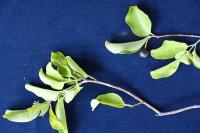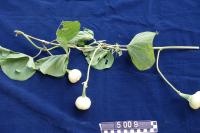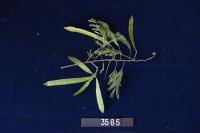Your search for * in food / domestic animals has returned 18 entries
incacas

n. herb to 0. 75 m tall, flowers white (collection: Michael J. Balick #4953)
Example: The young leaves are edible; these should be collected, boiled for ca. 8 minutes and eaten with other foods such as cassava. This is one of the local leaves that is said to taste quite good when cooked and mixed with other foods. Both the ripe (red) and unripe (green) fruits are added to soup and other foods as a spice or eaten fresh. The fruit of this cultivar is very hot. The fruit is also fed to chickens who seem to love to eat it.
bookmarkincauinja
incijiñyat

n. tree, 4 m tall (collection: Gregory M. Plunkett #3573)
Example: 1. This plant is used as firewood, but also the heartwood is sold. 2. In 2016, the first grade wood was 2500 VT per kilo, the second grade wood was 2000 VT per kilo. 3. The ancestors used to take the oil or wood chips from this tree and bathe with it to keep away evil spirits of the forest. It is currently planted on Aneityum for commerce. Scrape bark of sandalwood into coconut oil in same wat as GMP 3513 (gardenia) boil and take out the bark. 4. The leaves can be fed to pigs to make them strong and heavy.
bookmarkingitjiñat

n. small tree, 2 m tall (collection: Gregory M. Plunkett #3528)
Example: 1. This plant is used as firewood, but also the heartwood is sold. 2. In 2016, the first grade wood was 2500 VT per kilo, the second grade wood was 2000 VT per kilo. 3. The ancestors used to take the oil or wood chips from this tree and bathe with it to keep away evil spirits of the forest. It is currently planted on Aneityum for commerce. Scrape bark of sandalwood into coconut oil in same wat as GMP 3513 (gardenia) boil and take out the bark. 4. The leaves can be fed to pigs to make them strong and heavy.
bookmarkinmopoñ

n. tree, 10 m tall (collection: Gregory M. Plunkett #3516)
Example: The young stems are used to make fishing spears. These stems are also used to make the poles that connect an outrigger to a traditional canoe, as they are light and strong. The large trees have extensive roots and stumps and are used as a pen for pigs by making a fence from these.
bookmarkinmoupog

n. tree to 8 m, dbh 20 cm (collection: Michael J. Balick #4927)
Example: The wood of this tree is used as firewood. Children collect the dry fruits and use them for decorations and toys, for example playing with a fruit on the beach, driving it as if it were a toy truck or boat (photo).
bookmarkinmowad

n. vine to 40 cm, flowers blue (collection: Michael J. Balick #4949)
Example: To heal cuts, select a piece of the larger part of the stem (woody) cut a 6 inch piece and blow on one end; the sap comes o ut on the other end and this can be used to cover the wound. As a pig feed, people collect the stems and leaves and feed these to the pigs.
bookmarkinmowad u pikad

n. vine to 5 m tall in trees, fruits maturing yellow-brown. Growing in agroforest/secondary forest. (collection: Michael J. Balick #5009)
Example: People collect this vine and feed it to pigs. It also has an unspecified medicinal use. The vine of this plant forms a thick canopy so some people plant it around the house near trees that do not give much shade in order to reduce the intensity of the sun on the house and thus keep the temperature lower. The vine grows quickly into the trees.
bookmarkintesyaniau

n. grass to 3 m, flowers brown. Growing in degraded secondary forest along trail. (collection: Michael J. Balick #4969)
Example: The stem of this plant is used to make walls of houses. Collect the stem and remove the leaves, and then take one of the bush vines (any of them) and tie the stems into bundles for making house walls or fences for chicken pens. Children make a whistle from a hollow piece of stem from this plant.
bookmarklakasia

necñanjaa

n. shrub to 2 m, dbh 3 cm (collection: Michael J. Balick #4862)
Example: The common name of this plant refers to the footprint of a chicken. Mix the dried leaves of this plant with pieces of coconut and feed to chickens. They are said to really like it. Plant the shrub near the place that chickens are kept. This feed will make the chickens produce more eggs and also increase the number of healthy chickens.
bookmarknelm̃ai

n. tree to 4 m tall, dbh 8 cm (collection: Michael J. Balick #5004)
Example: This plant is used to make fishing line, perhaps moreso in the past than today. Collect young shoots form the sides of the tree, peel off the bark, soak the stem in salt water or fresh water for 1-2 weeks to ret the stems then separate the fibers, dry in the sun and use to make string for fishing. The leaves are used for feeding pigs.
bookmarknepya

n. tree, 6 m tall (collection: Gregory M. Plunkett #3541)
Example: 1. The young leaves are placed under a pig being cooked in the earth oven, on top of stones, the fat drips on the leaves and then people eat the leaves with pig fat on it--said to be delicious. The branches are used to make pig pen fences. 2. Collect top branches, chop leaves boil and eat like island cabbage – or cook on charcoal and wrap fish w/ this leaf.
bookmarkniyeg

n. grass to 1. 5-2. 0 m tall, inflorescence white. Red clay soil (collection: Michael J. Balick #4885)
Example: Cut this grass in the morning, let dry for 2 days, and then use to weave the roof of a house. This is thicker and heavier than a coconut leaf. Also, use for cyclone house. (see photos of house) When indicating something is Tabu, tie the leaf and put it in an object like ripe bananas and people know it is Tabu and will not take it away.
bookmarkniyeg

n. grass, 2. 5 m tall (collection: Gregory M. Plunkett #4071)
Example: 1. Dried leaves are used to make the thatch roofs of traditional houses. The same leaves are woven to make the walls of traditional houses. 2. When a large torch is required, many dried stems are bundled to form a flambeau. 3. The leaves of this plant are used to demarcate tabu areas. Further information about the practice withheld.
bookmark




